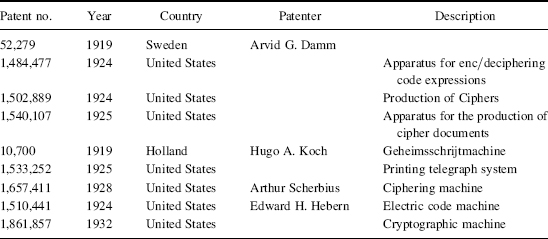6.3 ROTOR PATENTS
The discovery of the rotor led to the implementation of several electromechanical cryptographic systems, which were patented (Table 6.1). Hebern's rotor machine (Fig. 6.5) used a typewriter (2) to input plaintext consisting of the letters A, B,…, Z. Ouput was signaled by lamps (37) located just above the keys (4). The rotors, five in Figure 6.5 (75a–e), have window (7), which allow their positions to be viewed.
Edward Hebern, born in 1869, spent his adult life trying to use cryptography to better himself financially. He was not discouraged at all when a solution to his magazine advertisement of an unbreakable cipher in 1921 was provided by a naval cryptanalyst. Hebern was at the right place at the right time as the U.S. Navy was seeking a quality cryptographic system. Hebern set off for Washington D.C. to seek his fortune selling his Electric Code Machine. Anticipating success from his Washington outing, the Hebern Electric Code Company was established in Oakland, California. He advertised his cipher machine using the ode:
TABLE 6.1 Patented Electromechanical Cryptographic Systems

Marvelous invention comes out of the West
Triumph of patience, long years without rest
Solved problem of ages, deeper than thought
A code of perfection, a wonder is wrought.
As part of the review process, Hebern submitted ten examples of ciphertext to the Navy for analysis. While they ...
Get Computer Security and Cryptography now with the O’Reilly learning platform.
O’Reilly members experience books, live events, courses curated by job role, and more from O’Reilly and nearly 200 top publishers.

